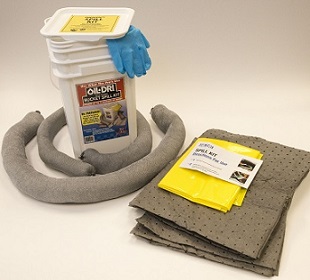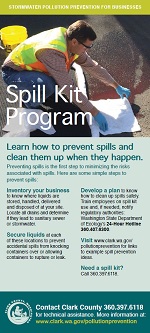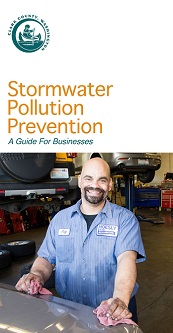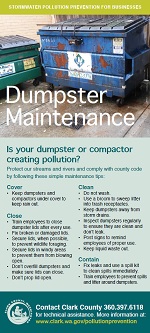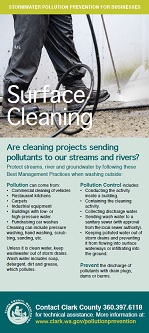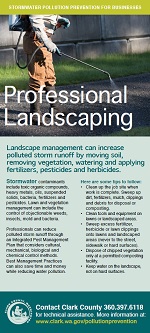Responding to spills
Spills happen. Be prepared by having a plan, a spill kit, and training employees on what to do. Businesses are required by law to report all spills. If the spill puts people at risk, call 911. Then follow the steps below and call 1-800-OILS-911 (1-800-645-7911) to report the spill.
Preventing spills is the first step to minimizing the risks associated with spills. Being prepared to keep spills from entering storm drains and water bodies can save your business from costly clean ups down stream.
1. Stop the spill
Safely stop the spill from discharging more contamination if possible.
2. Shut off ignition sources
Shut off any ignition sources, including cigarettes.
3. Contain the spill
Use booms or another type of mobile berm to keep the spill from spreading.
Block off the storm drain to prevent pollution from entering if necessary.
4. Clean up immediately
Apply an absorbent such as kitty litter or absorbent pads.
Sweep up absorbents, double bag and dispose of in the trash. Do not wash spills.
5. Report the spill
All oil and hazardous materials spills cause environmental damage. The sooner a spill is reported, the quicker it can be addressed, resulting in less harm to our environment and your business. Failure to report a spill you're responsible for could result in penalties.
If any spill appears to have an immediate threat to public health and safety, call 911 first.
To report a spill or surface water pollution in Clark County, call the Washington Department of Ecology 24-Hour Spill SW Region Response Hotline at 1-800-OILS-911 (1-800-645-7911).
Click here for additional information on reporting spills from Washington Department of Ecology.
Spill kit
Having a spill kit and employees that know how to properly use it can save your business time and money, while preventing pollution from reaching our streams and rivers. Keep spill kits at outside areas where there is a potential for fluid spills and ensure the kits are appropriated for the materials and size of the potential spill.
Spill kits should be stored in a water-tight container and have:
1. Safety gloves and personal protection equipment
2. Absorbent pads and oil containment booms
3. Disposal bags, polyethylene or equivalent
4. Containers or salvage drums, such as high density polyethylene, polypropylene or polyethylene sheet-lined steel
5. Shovels or other soil removal equipment
6. Emergency response guidebook
How to use your spill kit
1. Evaluate the situation,
including safety issues. Notify
owner, spill coordinator and
other necessary people. Put on
protective equipment. Follow
your spill plan.
2. Stop the source of the spill,
if it can be done safely, and turn off ignition sources. If unable
to stop the spill, call for assistance. If people or the environment are at risk call 911 immediately.
3. Protect the drain, by installing the drain cover and placing protective socks / booms in between the drain and the spill.
4. Clean up the spill with
appropriate materials,
including mats, pads, absorbent
clay, etc. Use a broom and pan
to clean up materials.
Never use a hose.
5. Dispose of all used
materials properly, including
securely tying the bag. If the
materials are hazardous, follow
local regulations for proper disposal.
6. Restock the spill kit and
return to the spill kit station.
Document the clean up effort
and notify the owner and/or spill coordinator that work is complete.
Report a spill or environmental concern
To report spills, dumping into surface water or storm drains, and illicit sewer and waste water connections to the stormwater drainage system, call: Washington Department of Ecology 24-Hour Spill SW Region Response Hotline at (360) 407-6300.
Quick links for businesses
Clark County Green Business Program
Dumpster maintenance
Preventing Pollution
Professional landscaping
Spill kits
Stormwater facility maintenance
Surface cleaning
